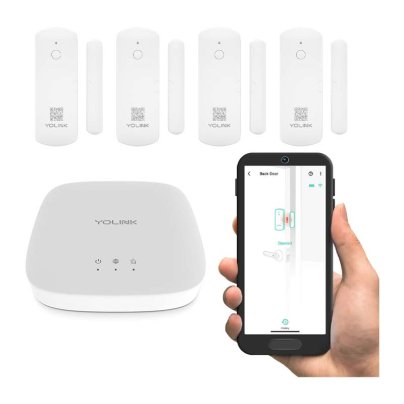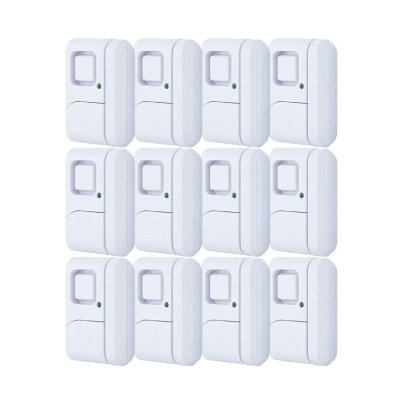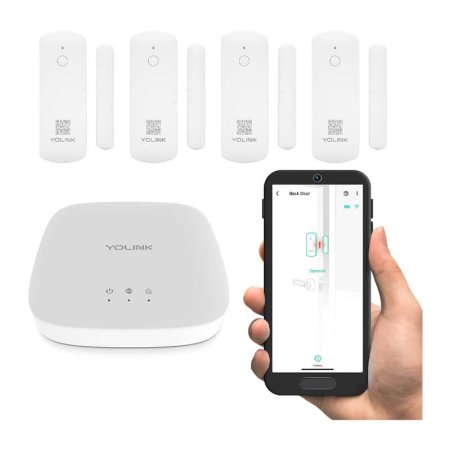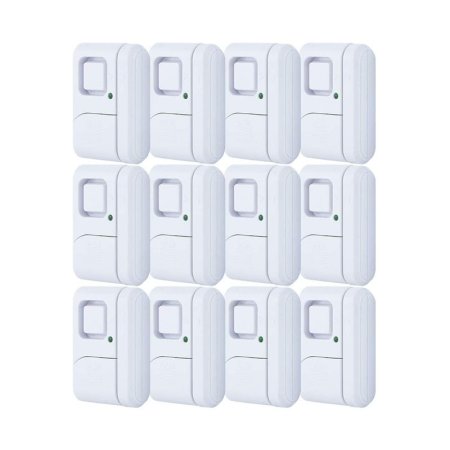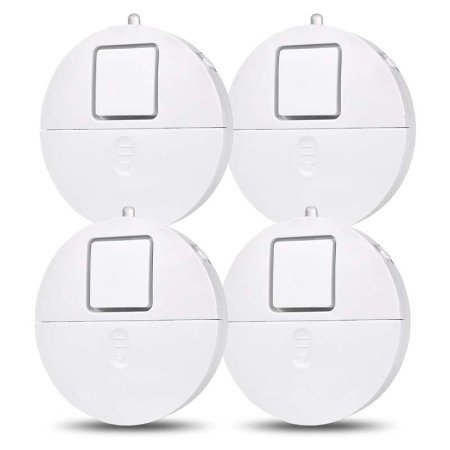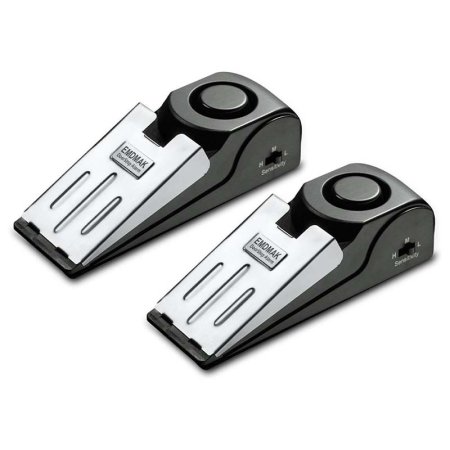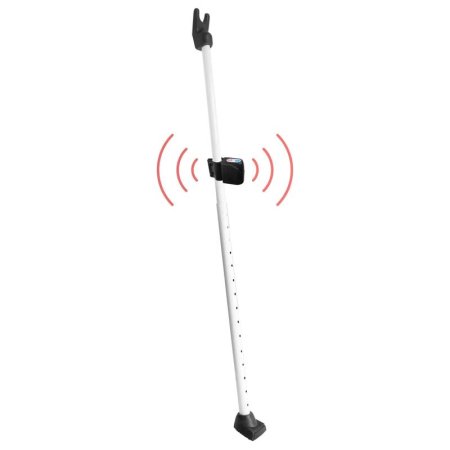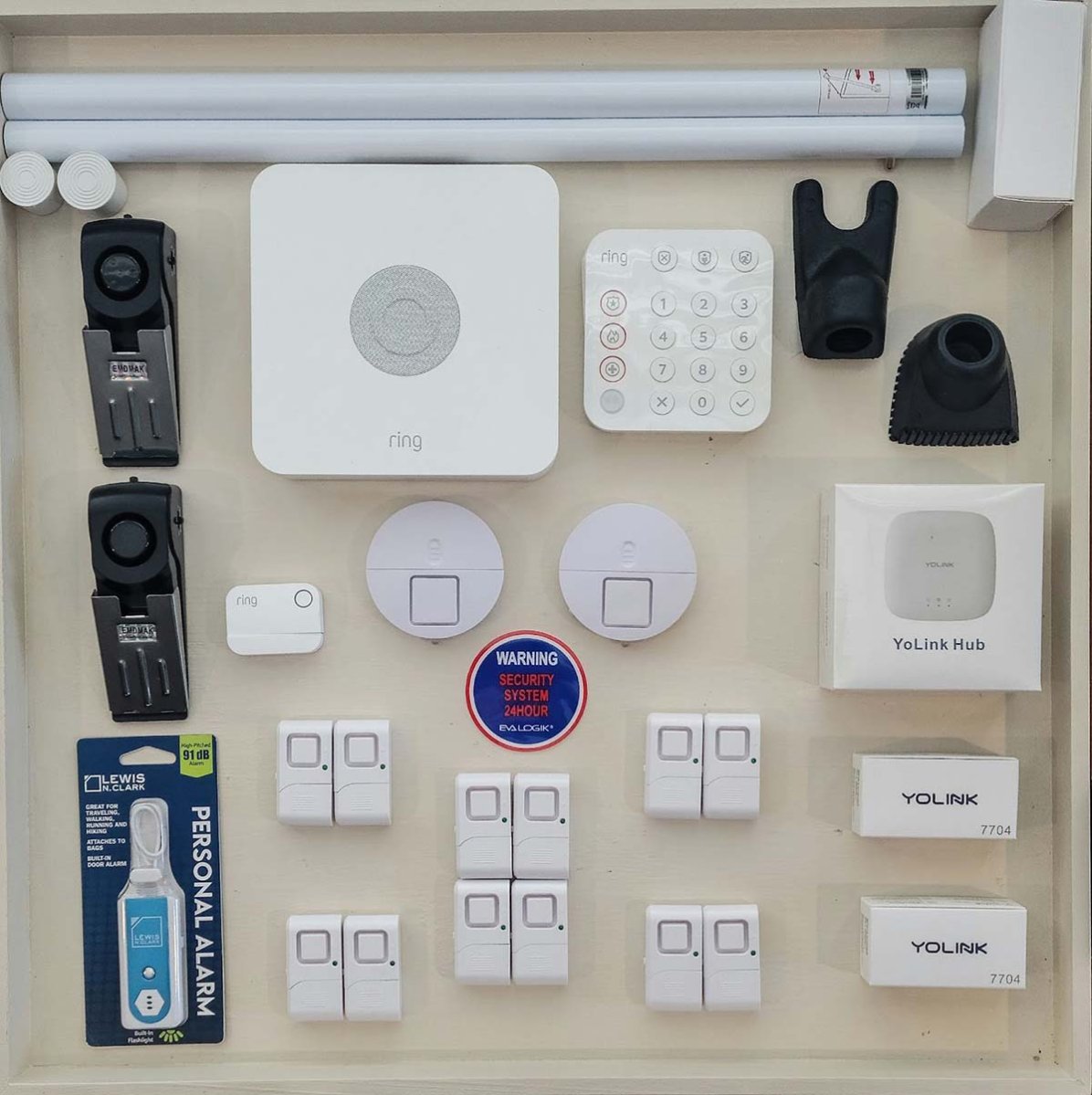
We may earn revenue from the products available on this page and participate in affiliate programs. Learn More ›
Security lighting and cameras can go a long way in keeping your home safe, but for many homeowners, the best forms of protection are piercing door and window alarms that can scare away would-be intruders while alerting residents. Some folks prefer to invest in a complete home security system that detects motion, records activity, and provides a startling siren.
The latest door and window alarms are not just loud; they’re more sensitive and convenient than ever—but which ones are best? We wanted to learn which of today’s popular products provided the most effective warnings, so we tested them. We installed them on doors and windows, and then we watched (and listened) as they set off their earsplitting sirens. We liked the YoLink Smart Window Door Sensors, LoRa ¼ Mile Range best and were impressed with its ability to transmit up to a quarter of a mile away.
The best alarm for a particular shopper will depend on several factors, including the type they prefer, where they wish to install it, and whether they’d like remote access. Ahead, find out about the different types available today and how the following models earned a spot in our lineup of the best door and window alarms.
- BEST OVERALL: YoLink LoRa Smart Window Door Sensors
↓ Jump to Review - BEST BANG FOR THE BUCK: GE Personal Security Window and Door Alarm
↓ Jump to Review - UPGRADE PICK: Ring Alarm 5-Piece Security Kit
↓ Jump to Review - BEST GLASS-BREAK SENSOR: Eva Logik Door Window Alarm With Vibration Sensor
↓ Jump to Review - BEST FOR TRAVEL: Emdmak Door Stop Alarm With 120 dB Siren
↓ Jump to Review - BEST WITH SECURITY BAR: SecurityMan Security Bar Door and Window Bar Alarm
↓ Jump to Review
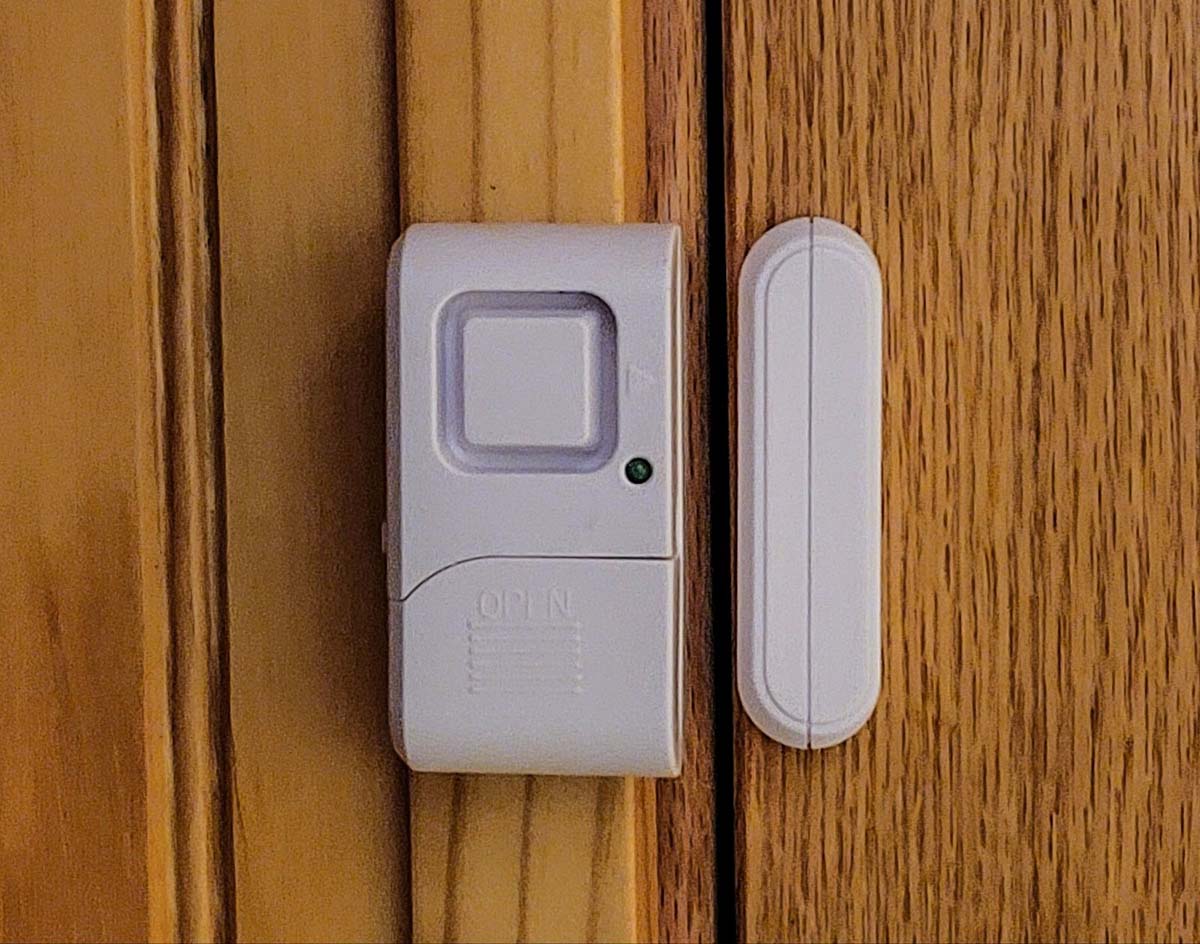
| Testing Stats | |
|---|---|
| Products tested | 7 |
| Time spent testing | 3.5 hours |
| Tests performed | 4 |
| Price range | $12 to $200 |

How We Tested the Best Door and Window Alarms
Before we selected door and window alarms for hands-on testing, we researched more than 25 different models and types, paying close attention to how they worked and studying the feedback from consumers who bought them.
Brand reputation was also a consideration. Both Ring and GE are nationally known companies that produce top-of-the-line home-security products and systems. But we didn’t automatically eliminate smaller or niche brands as long as their alarms featured quality components and users rated them highly. In the end, we opted to test the best prospects from a range of different types of alarms.
When testing alarms with remote access, we downloaded the corresponding apps and synced the sensors to our Wi-Fi or Alexa system. We configured the alarms using the apps or programming directly using a keypad (when applicable). We tried out all the functions, such as volume control, setting passwords, and engaging and disengaging the alarms from the app or the keypad.
We tested all the alarms, both the smart devices and the point-of-use models, by opening windows and doors (or trying to open them) to trigger the alarms. We noted how easy (or difficult) it was to set the alarms up, and we estimated their loudness if the manufacturer didn’t cite the decibel level. We used hearing protection after we tested the first alarm; it was so loud that it hurt our ears.
Throughout the testing process, we scored each product using a rubric. The better the product performed a function, the higher the score it received. After testing, we averaged the scores and used the results to help us categorize the alarms.
Our Top Picks
While many security products, such as cameras and floodlights, come with added alarms, we focused our testing on products where alarms were the primary functions. Not all of the products we tested earned a spot on this lineup. The models on this list excelled in our hands-on tests, and we’re confident that each is one of the best door and window alarms on the market.
Best Overall
YoLink LoRa Smart Window Door Sensors
Product Specs
- Type: Contact sensor
- Remote access: Yes, receive alerts on smartphone, Amazon Alexa, or Google Assistant
- Audible alert: No
What We Like
- Peel-and-stick sensors for easy installation
- Up to ¼ mile open-air wireless range
- Syncs with YoLink app, If This Then That (IFTTT) app, Alexa, Google
What We Don’t Like
- No audible alerts from sensors
We opened the package to find four standard contact sensors and a hub. Then we downloaded the YoLink app, which walked us through syncing the hub with our Wi-Fi network; it was quite simple.
We installed one of the contact sensors on an interior door, and the YoLink app detected it and prompted us to name it. We called it “master bathroom.” The sensor sent an alert to our smartphone when we opened the door. We then installed the rest of the sensors on other doors in the house. They all worked similarly, sending alerts to our phone when a door was opened. That was all to be expected—but then came the surprises.
A few minutes later, we got another alert on our phone—even though we hadn’t opened any door. A quick app check told us the master bathroom door was still open! We found we could configure the app to notify us if any door had been left open for a set amount of time.
A bigger surprise still awaited. We removed one of the sensors we’d placed on an interior house door and took it to our shop, which sits about ⅛ mile away from the house. We installed it on the shop door, not really expecting it to work, but when we opened the door, we got an alert on our smartphone.
We really liked the YoLink alarms, but we wished they also offered an audible alert function, such as a chime or a siren that sounded when a door was open. Still, that’s a minor gripe for what’s basically an excellent long-range security solution. Remember that a smartphone (or Alexa or Google device) is needed to receive alerts. YoLink can be configured to work with an Alexa device, such as an Echo Show.
What our tester says: “While regular Wi-Fi and Bluetooth rarely work at a long distance, the YoLink hub communicates with the sensors via LoRa technology—transmitting up to ¼ mile away. I found that very impressive.”—Glenda Taylor, Product Reviews tester & writer
Get the YoLink door and window alarm at Amazon, YoSmart, or Walmart.
Best Bang for the Buck
GE Personal Security Window and Door Alarm
Product Specs
- Type: Contact sensor
- Remote access: No
- Audible alert: Yes
What We Like
- Very loud alarm
- Optional chiming sound
- Easy to install
What We Don’t Like
- Doesn’t sync with Wi-Fi or smart devices
These GE window and door alarms prove that you needn’t spend a lot to get a measure of security. At first glance, these alarms, which have peel-and-stick pads for easy installation, look like virtually all contact sensors. But, wow, are they loud—way louder than we thought they’d be.
These door and window alarm sensors come with batteries preinstalled, so we aligned the two parts of the sensors on doors and started testing. A small switch on the side of each sensor turns the unit on or off or selects Chime or Alarm. The chime is a nice-sounding doorbell sound that is easy to hear from adjoining rooms, but the alarm is truly ear-piercing. We literally jumped when we opened the door and triggered the alarm function.
While these GE contact sensors won’t sync to a home security system or Wi-Fi, they should certainly fit the bill for those looking for an affordable, ear-splitting alarm to scare off intruders.
What our tester says: “The manufacturer claims that the alarm is 120 decibels (dB), and while I didn’t have a sound tester, it startled me enough to wear ear protection while testing the sensors.”—Glenda Taylor, Product Reviews tester & writer
Get the GE door and window alarm at Amazon or Walmart.
Upgrade Pick
Ring Alarm 5-Piece Security Kit
Product Specs
- Type: Contact sensor, motion detector
- Remote access: Yes
- Audible alert: Yes
What We Like
- Loud siren-type alarm
- Control from keypad or smartphone
- Added motion-detection function
- Additional sensors can be added later
What We Don’t Like
- Range extender didn’t work too well
- Only 1 contact sensor included
From a well-respected manufacturer of home-security products comes the Ring Alarm kit, which is just the right size for offering advanced protection for apartment dwellers or those in small homes.
The first thing we did was download the Ring Always Home app and set up an account. The app walked us through the setup process, which included syncing with Wi-Fi. The system has five modules: a hub, a range extender, motion detector, keypad controller, and a contact sensor. We were able to configure each one easily through the app.
We found the contact sensor and motion detector very responsive—they sent immediate alerts to our smartphone. However, we weren’t too impressed with the range extender, which allowed us to locate the sensor only about 30 feet farther away than when we didn’t use it. We would have preferred a second contact sensor that we could have installed on another door or window.
The system offers three modes: Home, Away, and Disarmed. In Home mode, the contact sensor still sent alerts, but the motion detector was disabled. In Away mode, we received alerts from both the contact sensor and the motion detector. In Disarmed mode, we received no alerts. We could also choose an audible-alarm feature that was very loud; the manufacturer doesn’t list the decibels, but we estimated it was between 100 and 105 dB based on comparison to the other alarms we tested.
We were able to arm/disarm the system by entering a code, either on the keypad or on our smartphone. The keypad can also be configured to call the police or fire department automatically at the touch of a single button. We didn’t test that feature. We found the Ring Alarm system worked well and was easy to use from the keypad or our smartphone. Users can purchase real-time monitoring through a subscription service if desired.
Get the Ring door and window alarm at Amazon, The Home Depot, or Best Buy.
Best Glass-Break Sensor
Eva Logik Door Window Alarm With Vibration Sensor
Product Specs
- Type: Glass break (vibration) sensor
- Remote access: No
- Audible alert: Yes
What We Like
- Easy to apply to window
- Warning sticker visible to potential intruders
- Loud whistlelike alarm
What We Don’t Like
- Vibration sensitive only; not sound sensitive
- Not enough stickers to affix all 4 sensors
With a stationary window that doesn’t open, a standard contact-sensor alarm will be useless. That’s where a glass-break sensor can come in, setting off an alarm if the pane of glass is broken. The Eva Logik sensors we tested were vibration (not sound) sensors, so they had to be in contact with the glass as it broke.
The package includes four sensors, each of which attaches to glass via a double-sided sticker. The stickers display a warning to would-be intruders that the home is protected. Unfortunately, our package came with only two stickers. This was clearly an error, but after checking product reviews, we found other buyers didn’t receive all four stickers either. Fortunately, two-sided tape can be used to hold the sensors in place on a window.
Rather than actually break a window in our home, we affixed an Eva Logik sensor to a 12-inch-long by 12-inch-wide sheet of clear glass—a simple process. We then placed the pane on the ground outdoors, laying it on a towel to collect broken shards, and hit the center firmly with a hammer to break it.
As the glass shattered, the Eva Logik let out a hair-raising squeal that sounded more like a high-pitched whistle than a siren. While the manufacturer doesn’t list the actual decibel level, we estimated it to be about 95 dB compared to the other alarms. The downside to this type of alarm is that a separate sensor is needed for every window since it detects vibration and not sound. Those with multiple windows to secure may prefer a glass-break sound sensor, which is designed to detect the sound of glass breaking and set off an alarm.
Get the Eva Logik door and window alarm at Amazon or Walmart (8-pack).
Best for Travel
Emdmak Door Stop Alarm With 120 dB Siren
Product Specs
- Type: Pressure sensor
- Remote access: No
- Audible alert: Yes
What We Like
- Easy to use—just wedge under door
- Deafening siren
- Rubber base helps keep the door from opening
What We Don’t Like
- 9-volt battery not included
- Pressure-sensitivity adjustment didn’t work
Small and lightweight, the Emdmak door alarm system is well suited for travel. It won’t take up a lot of space in a bag or duffel, and it’s super easy to use: Just wedge it under the door. As the only alarm tested that didn’t come with preinstalled batteries, we first had to locate and put in the required 9-volt battery. We closed a door, then slid and snugly wedged the Emdmak doorstop device underneath. The device offers low, medium, and high sensitivity levels, so after turning it on, we selected the high sensitivity level to find out just how little pressure we could put on the door before the alarm sounded.
When we attempted to open the door, an incredibly loud alarm sounded. The manufacturer lists it at 120 dB, and we believe it—we were wearing ear protection and still ran away from the area. When we retested the device on both medium and low sensitivity levels, we found no discernible difference in the sensitivity settings. In short, the alarm went off if we exerted only slight pressure on all three settings. Knocking on the door didn’t set off the alarm on any setting, but as soon as we turned the knob and pushed the door a tiny fraction of an inch, the alarm sounded.
Another attribute of this door alarm is its nonskid rubber base that doesn’t slide, which makes it even harder to force open the door, although the piercing alarm alone would likely deter most intruders. We felt this added a valuable measure of security and safety for the user, whether at home or traveling in an unfamiliar area where folks might feel somewhat more anxious.
Get the Emdmak door alarm at Amazon or Walmart.
Best with Security Bar
SecurityMan Security Bar Door and Window Bar Alarm
Product Specs
- Type: Vibration sensor
- Remote access: No
- Audible alert: Yes
What We Like
- Very loud siren
- Prevents door from being pushed open
- Works on sliding glass doors as well
What We Don’t Like
- Tiny screws and nuts require tools to install sensor
- Very sensitive vibration sensor
This door open sensor and security bar does double duty by preventing entry and emitting a loud alarm. It reminded us of the old standby tactic of wedging the back of a chair under a doorknob to prevent an intruder from pushing the door open; but this device works much better thanks to its clever design and rubber-grip foot that didn’t slide when we tested it on hardwood, ceramic tile, and carpeted flooring.
The metal bar adjusts to fit different door knob heights. It can also be used in the track of a sliding door by switching out the end pieces for smaller rubber endcaps (included). The robustness of the blocking bar is matched by the sound of its ear-splitting alarm. The manufacturer cites it as 120 dB, and it certainly seemed that way to us despite the hearing protection we wore.
The included sensor that we attached to the bar detected even subtle movements, sounding the alarm when we applied the slightest pressure. A light tap did not set it off, however.
Our complaint is in how the sensor attaches to the bar. The two small screws and nuts that are used to tighten the sensor on the bar are so small, we had to use a Phillips screwdriver to twist the screw and a set of pliers to hold the nut on the backside. If users take the bar traveling with them, they might want to attach the sensor before they leave home.
What our tester says: “It’s very sensitive, so while it would surely shriek if someone tried to push the door open, it also set off the alarm when I gave the door a firm knock.”—Glenda Taylor, Product Reviews tester & writer
Get the SecurityMan door alarm at Amazon or The Home Depot.
Also Tested
In addition to the Ring Alarm Security Kit we tested, we also tested a single Ring Alarm Contact Sensor, but it must have been a lemon. We’ve tested many Ring products in the past and they’ve always performed well, but this contact sensor just wouldn’t sync with the Ring app. We even tried uninstalling the app after testing the more comprehensive Ring Kit and reinstalling it on the off chance the kit was somehow interfering. Still, the app never detected this individual sensor.
We had to eliminate this sensor from our tests, but we’re still fans of Ring, and we feel this was a fluke. We would not hesitate to purchase another contact sensor or any Ring product in the future.
Jump to Our Top Picks
What to Consider When Choosing a Door and Window Alarm
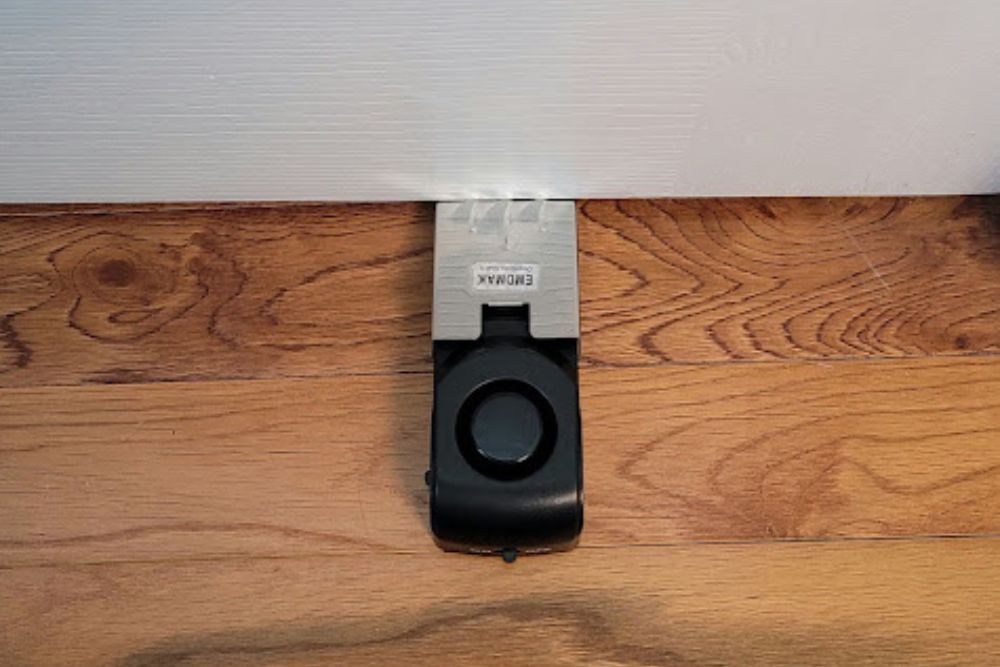
Whether selecting the best door and window alarms for a workshop, home, or office, there are several factors to consider, including remote accessibility, pet-protection features, and camera access.
Remote Accessibility
Accessing a security system from anywhere in the house or when away offers a level of security and confidence that isn’t possible with point-of-use-only systems. Receiving an alert on a smartphone allows users to respond immediately to the situation instead of arriving home to a blaring alarm and a broken window after the intruders have already left. Some alarms come with their own app, while others use a universal app, such as IFTTT, to provide remote access.
Remote accessibility can also allow users to turn off the security system if they’re away from home and would like a friend or neighbor to check on the house. This type of system typically syncs with a home Wi-Fi network and can be operated remotely via a smartphone, tablet, or PC.
Pet Protection
The primary purpose of pet security products is to monitor companion animals’ activity via a camera and perhaps allow the owner to interact with the pet using real-time voice controls. These systems may comprise pet doors, indoor or outdoor motion sensors, treat dispensers, and the ability to give an audible notification to the owner when a pet goes outside.
Though pet security alarms may function the way standard door and window alarms do, the sound they emit usually isn’t loud enough to frighten the animal. Many smart-type contact sensors allow the user to turn off audible alarms and receive alerts on a smartphone instead. Door and window alarms designed to frighten intruders are likely to produce a sound that would also scare animals too, not to mention annoy the pet owner every time a pooch goes out to bark at a squirrel or do his business!
Camera Access
While a simple door and window contact sensor alarm offers a measure of security, a camera offers added protection. Security cameras allow users to see and record video inside or outside a home. Security cameras may have internal memory or upload video to a website or an app, giving the user access to live feeds from a smartphone.
The alarms are often secondary to the cameras themselves. Some camera-type alarms sound like sirens to frighten away an intruder, while others are silent but send an alert to the user’s phone, an indoor receiver, or law enforcement. Cameras and alarms that feature remote access and alerts typically require a Wi-Fi network to operate, but a few will send signals via Bluetooth over a shorter distance, typically up to 150 feet away.
Types of Door and Window Alarms
Contact sensors and motion alarms are the two main types of door and window alarms. There also are specialized door and window alarms that detect abnormal vibration or the sound of broken glass. Some of these alarms are so loud that we had to wear ear protection when testing them. They are certainly loud enough to deter most unwanted visitors, but for full home security, it’s best to use more than one type of alarm.
Contact Sensors
Contact sensors are the most common type of door and window alarm. Their basic, affordable design typically relies on two sensors that must be aligned for the system to be armed. One sensor is installed on the door or window, while the other is installed directly beside it on the door frame or window frame. Mounting is often simple, featuring peel-and-stick backing that securely holds the sensors in place.
After both sensors are installed and the system is turned on, any movement—such as the door opening—triggers the alarm, which is typically very loud.
Motion Alarms
Motion detectors and alarms are regularly used in comprehensive security systems to help detect the presence of an intruder and sound an alarm. They are often connected to a security camera or flood light that will activate when the motion alarm detects activity. The alarm is often quite loud to scare intruders away while the camera records what’s happening.
These devices are usually installed outside a home but can be set up indoors if necessary. They use a motion-detection sensor to determine if anything is moving within a range specified by the manufacturer, typically around 15 to 35 feet. The range and sensitivity of these motion detectors vary greatly, so research products before deciding.
Specialized Door and Window Sensors
Some door and window security sensors are designed for very specific circumstances. There are those that detect the sound of glass breaking or strong vibrations in a window or door that could indicate an intruder trying to break in. Others detect pressure that triggers the alarm sound.
- Glass sound sensors detect the sound of glass breaking and set off an alarm. They can be placed anywhere in a room, and if an intruder breaks a window to gain entry, the device’s sound sensor will trigger a piercing alarm. In general, glass-break sensors are beneficial when a contact sensor isn’t suitable, such as on a stationary window that doesn’t open. The upside to a sound-type sensor is that it will set off an alarm no matter which window breaks, so there’s no need for more than one alarm per room. The downside is that breaking a drinking glass will also set off the alarm.
- Glass-break vibration sensors differ slightly from their sound sensor counterparts. They detect the vibration—not the sound—of a glass pane as it breaks, so they must be installed directly on the window itself. The upside is that breaking a drinking glass will not set them off, but the downside is that every window the user wants to secure must have its own alarm installed.
- Vibration sensors are applied directly to a window or a door and detect vibrations that run through the material. The vibration will trigger the alarm if it exceeds a certain threshold. However, these alarms can sometimes be triggered by heavy rain, snow, hail, or just someone knocking on the door, so they could result in false alarms.
- Pressure sensors are triggered when pressure is exerted on the sensor. It comes in two main types: door stops that slide under a closed door and security bars designed to be wedged beneath a doorknob. In both cases, if someone attempts to open the door, the pushing pressure sets off the alarm.
FAQs
If you still aren’t sure which door and window alarm system would be best for you, the following answers to some of the most commonly asked questions may help.
Whether or not you need sensors on every door and window depends on the type of alarm. Some glass-break detectors and door motion sensors can often cover more than one access point, while others detect vibration or pressure from a single point. Either way, make sure the most vulnerable entry spot in the home has an alarm.
Some alarms come with test buttons, but others should be tested by trying to open the door or window in question to ensure they’re working. In some cases, you can test sensors connected to an app by simply checking the diagnostic in the app.
Usually, the alarm is triggered by opening a window while the system is armed. However, there are window alarms that allow you to open your window narrowly without activating the alarm so that you can get fresh air from outside without sacrificing safety.
Basic door detector sensors do not require Wi-Fi. They use a short-range radio frequency signal, which is unrelated to Wi-Fi.
While the shelf life of the battery can be up to 10 years, that lifespan is shortened depending on how often the device is triggered. Typically, the lifespan of an alarm battery that’s used frequently is about 2 years.
Window and door alarms can certainly be worth it. For a reasonable cost, you can buy a system that is easy to install, deters burglars, and gives you peace of mind.
Why Trust Bob Vila
Bob Vila has been America’s Handyman since 1979. As the host of beloved and groundbreaking TV series including “This Old House” and “Bob Vila’s Home Again,” he popularized and became synonymous with “do-it-yourself” home improvement.
Over the course of his decades-long career, Bob Vila has helped millions of people build, renovate, repair, and live better each day—a tradition that continues today with expert yet accessible home advice. The Bob Vila team distills need-to-know information into project tutorials, maintenance guides, tool 101s, and more. These home and garden experts then thoroughly research, vet, and recommend products that support homeowners, renters, DIYers, and professionals in their to-do lists.
